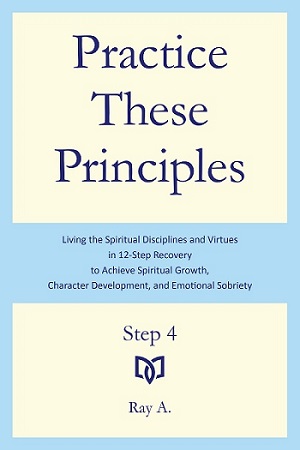
"Step 4 is arguably the hardest Step to work—if by hard we mean how much effort it takes. What, after all, are we doing when we first take inventory? We are looking back over the entirety of our past life and examining every situation and every relationship we were in that involved harm and wrongdoing. That is not a small undertaking. If seriously pursued, it necessitates a great deal of soul-searching: a lot of probing, recollecting, reflecting, thinking, and writing. We can leave no stone unturned as we assess the trail of destruction we have left behind. Our goal is to know the hardest and the scariest thing there is to know: ourselves—and then do something that is just as hard and scary: change.
For all of these reasons, Step 4 is also the Step we are probably most reluctant to embark upon. Many of us fear it, because of the work it entails and because of the painful memories it is likely to stir up. Sometimes the stumbling block is pride. We don’t think there is anything seriously wrong with us. Our main problem was drinking, and now that we are sober it is time to move on with our lives and let bygones be bygones. If we manage to get past these obstacles and become willing to take the Step, we may be faced with still another hurdle: we simply don’t know what to do. In most cases, this is because we haven’t consulted the Big Book and the 12&12. But even when we have, many of us may remain confused. We are not alone. Most alcoholics have questions about Step 4. Some have a lot of questions. In this book, we raise them.
What, to begin with, is an inventory? What makes it moral? What makes it searching and fearless? What does it mean that it is “of ourselves”? What are we to understand by the “character” and the “emotions” we are supposed to examine in it? How do these interact? What makes them go wrong? How do they cause us to hurt ourselves and others? How can we alter them so that we can stop doing harm and start living the life we are called to live, a life of love and service, of freedom and flourishing? And what has any of this to do with a “spiritual awakening” or with God?
To address these and other critical questions, this book probes deeply into Step 4 as it is laid out in the Big Book and the 12&12. This requires a very close reading of each of those two texts. It also requires a faithful reading, one that adheres to the spirit and the letter of both and that is backed up with extensive references to, and where possible direct quotations from, key passages. It requires that we relate the texts to each other and explore where they coincide and where they differ. In addition, it requires that we place the Step in its historical context. AA did not invent the idea of self-examination, and to act as if it did is to operate in a vacuum. Therefore, we inquire into its origins and evolution, what the program borrowed from the past, how it improved on it, what it rejected and why, and how its final version varies from other current and alternative versions. Finally, it requires that we translate all of this into a practical instrument with a clear set of guidelines, one that can direct our search, help us organize our material, and make our inventory into the effective tool for self-knowledge and self-transformation it is designed to be.”
- From pp. ix – x